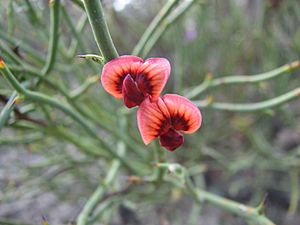Leafless bitter-pea facts for kids
Quick facts for kids Leafless bitter-pea |
|
|---|---|
 |
|
| Daviesia brevifolia at Anglesea Heath, Victoria | |
| Scientific classification | |
| Kingdom: | |
| (unranked): | |
| (unranked): | |
| (unranked): | |
| Order: | |
| Family: | |
| Genus: | |
| Species: |
D. brevifolia
|
| Binomial name | |
| Daviesia brevifolia |
|
| Synonyms | |
|
Daviesia brevifolia Lindl. var. brevifolia |
|
The Leafless Bitter-pea (its scientific name is Daviesia brevifolia) is a special kind of shrub. It looks a bit like a broom and belongs to the pea family, called Fabaceae. You can only find this plant growing naturally in Australia. This means it is endemic to Australia, which means it doesn't grow anywhere else in the wild.
About the Leafless Bitter-pea
What it Looks Like
This shrub can grow up to 1 metre (about 3 feet) tall. Instead of regular leaves, it has special flattened stems called phyllodes. These phyllodes have pointed tips that curve backwards. They are quite small, only about 2 to 5 millimetres long. Sometimes, younger plants might have rounder, egg-shaped leaves too.
The Leafless Bitter-pea produces pretty flowers that look like small peas. They can be apricot to brown-red in colour. These flowers usually appear between August and October. After the flowers, the plant grows puffy seed pods. These pods are about 15 millimetres long and 10 millimetres wide.
Where it Grows
This plant is native to parts of Australia. You can find it growing in the wild in South Australia and Victoria. It thrives in these areas, showing off its unique look and colourful flowers.
How it was Discovered
The Leafless Bitter-pea was first officially described in 1838. An English botanist named John Lindley gave it its scientific name. He wrote about it in a book called Three Expeditions into the interior of Eastern Australia. This was an important step in understanding and recording Australia's amazing plant life.

